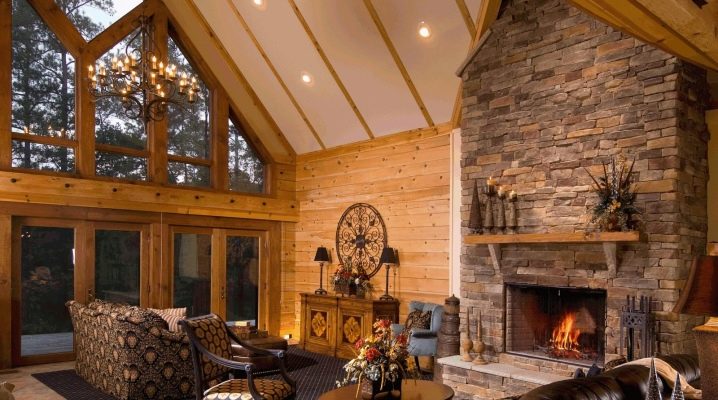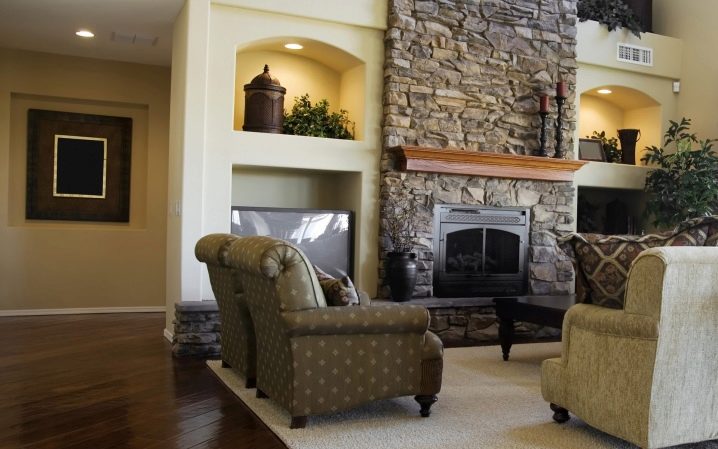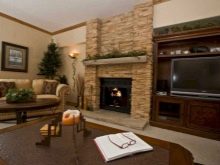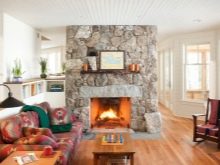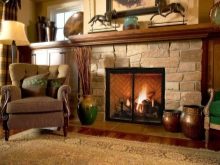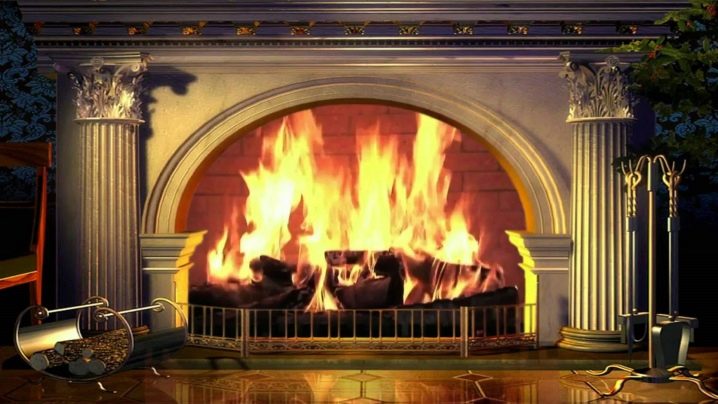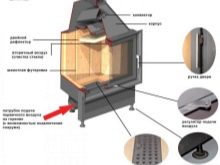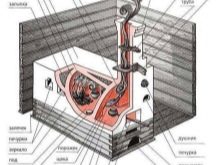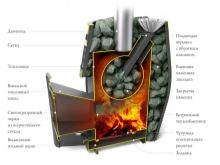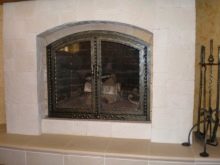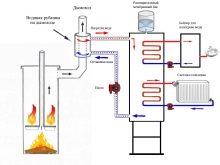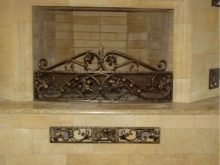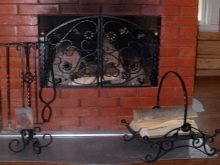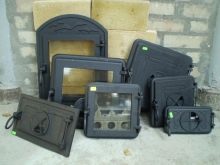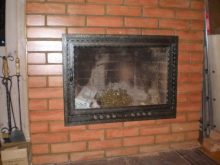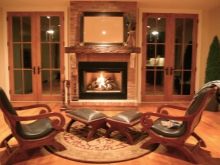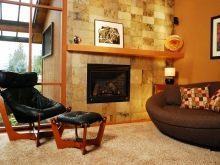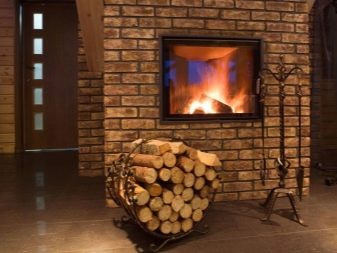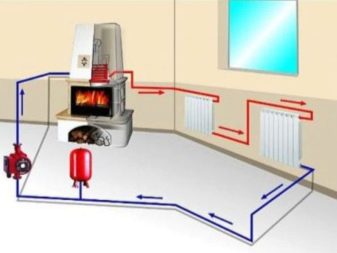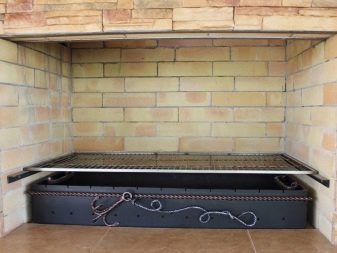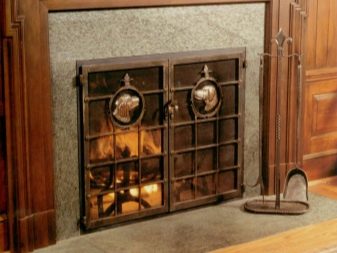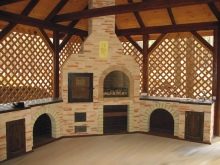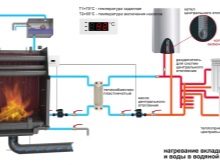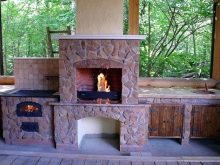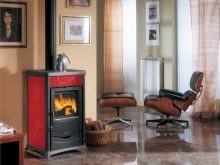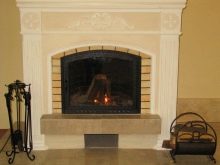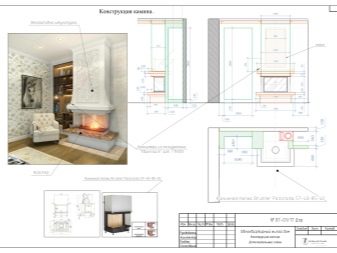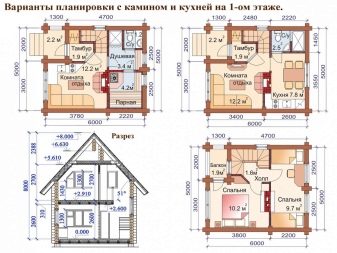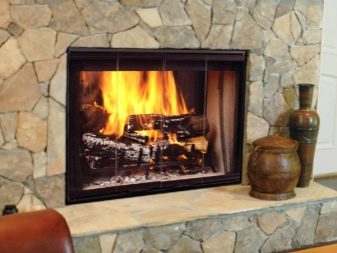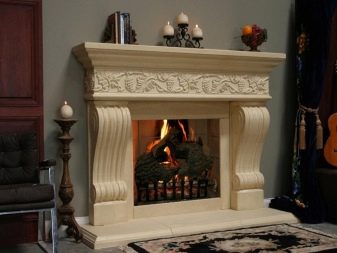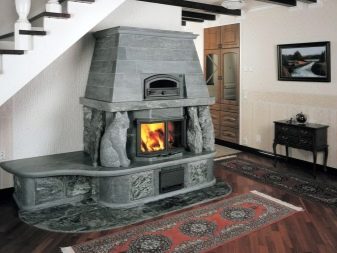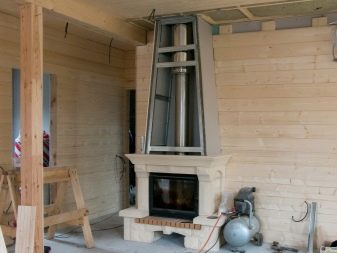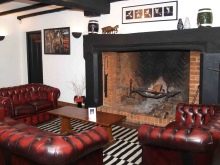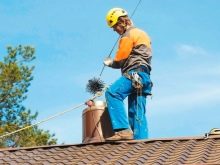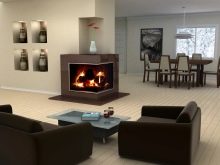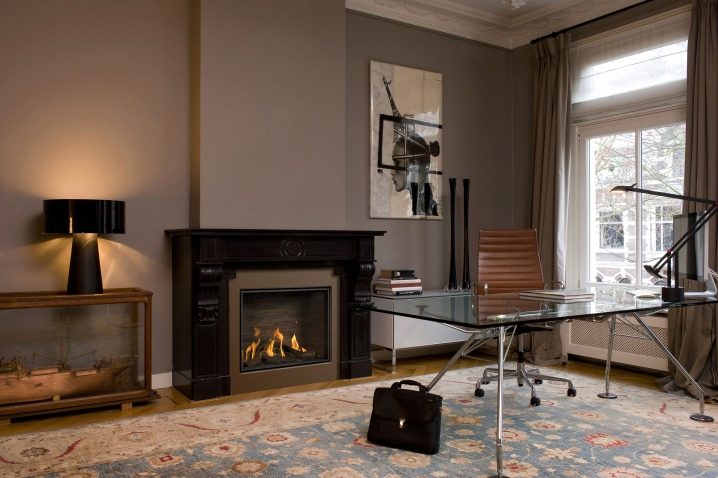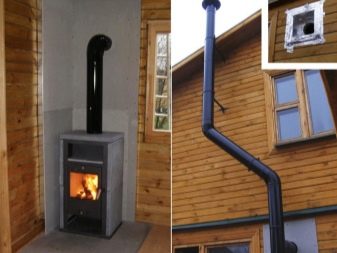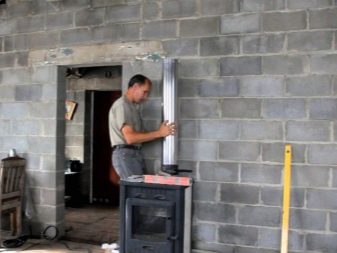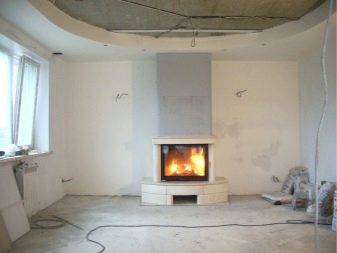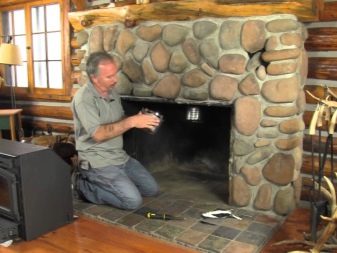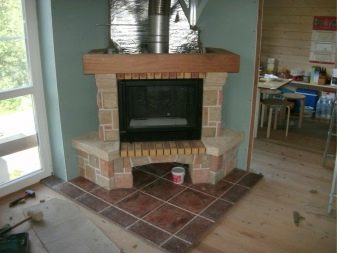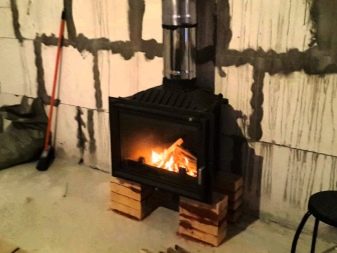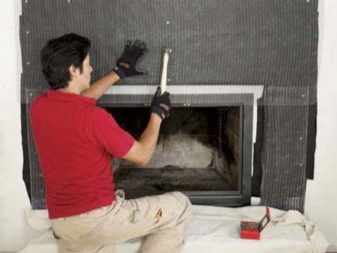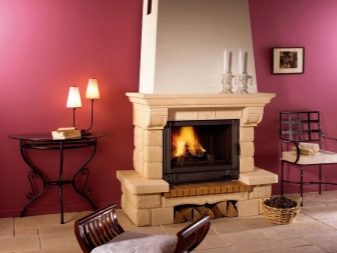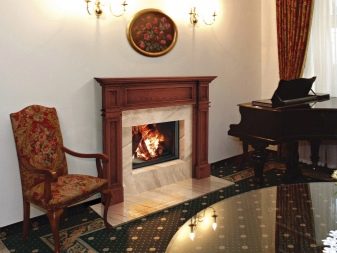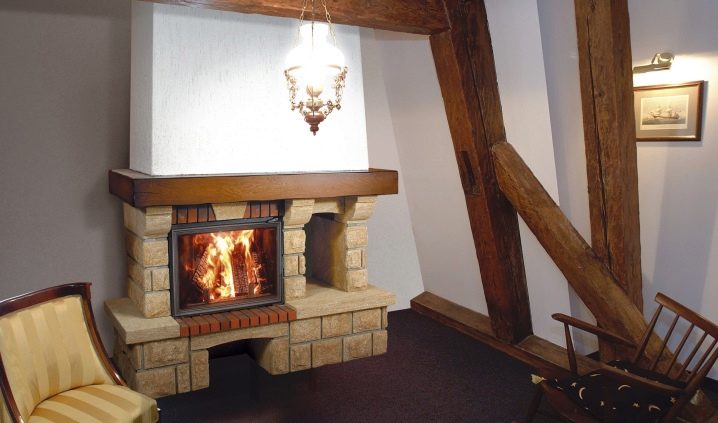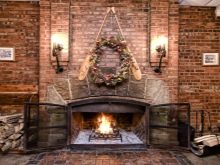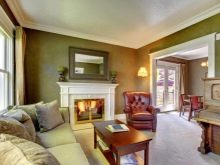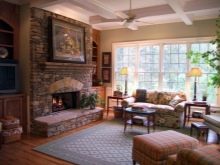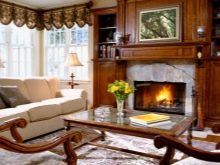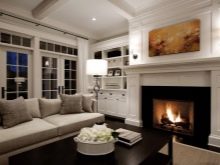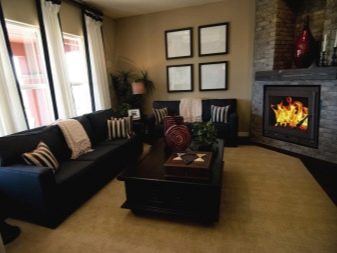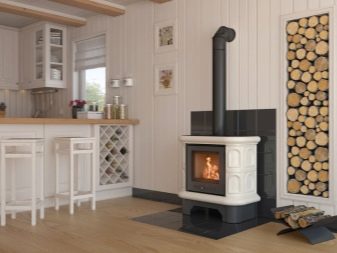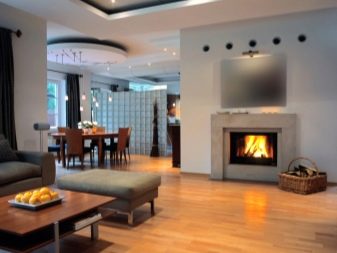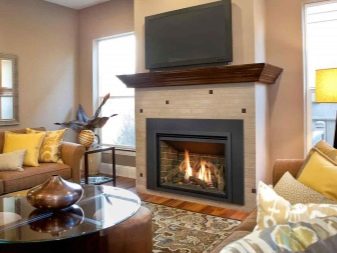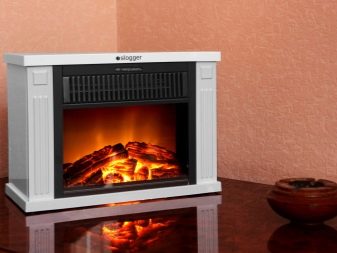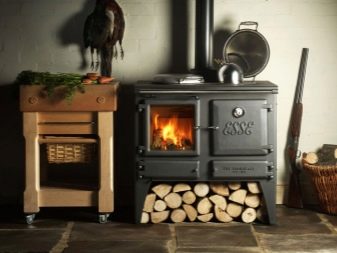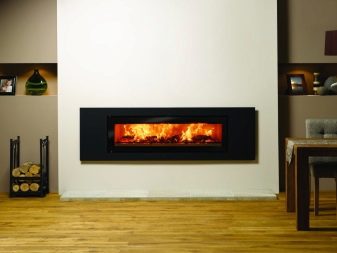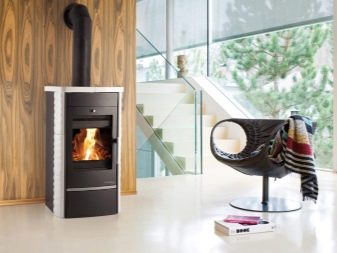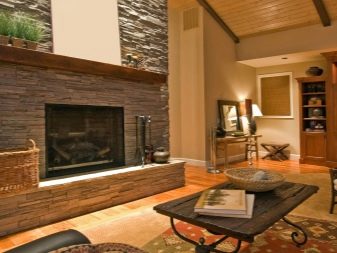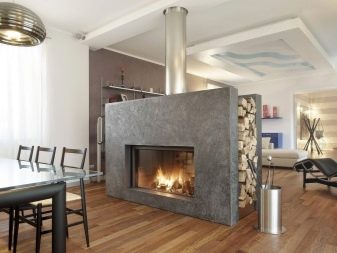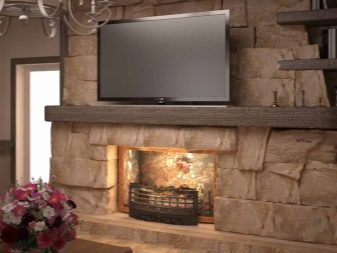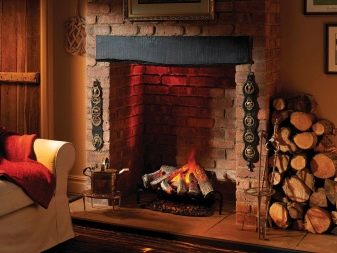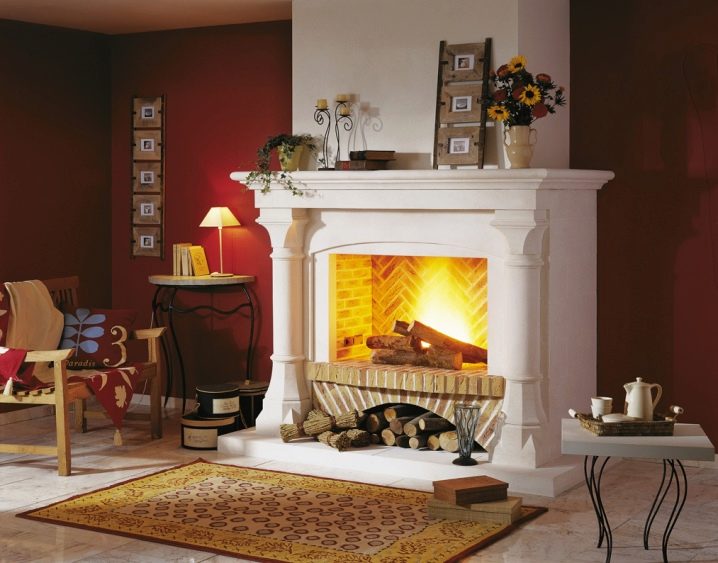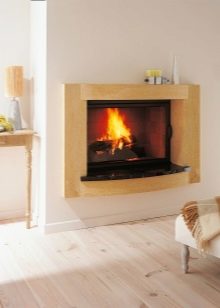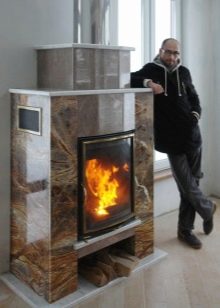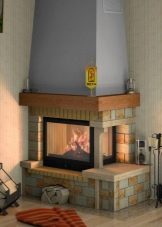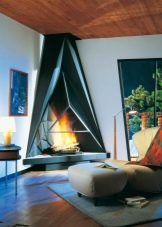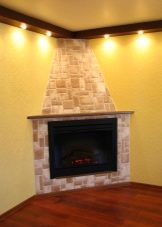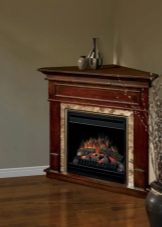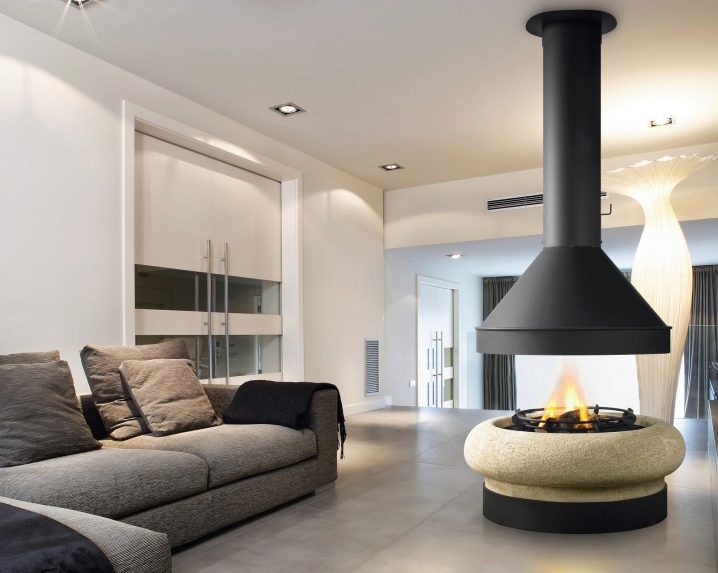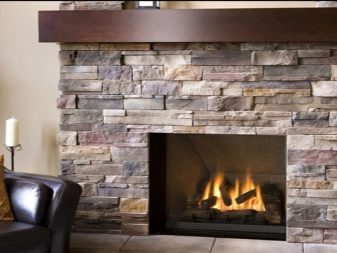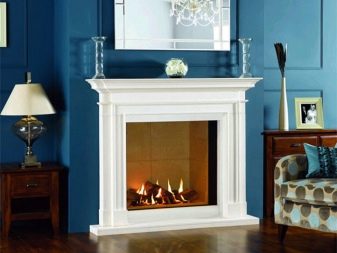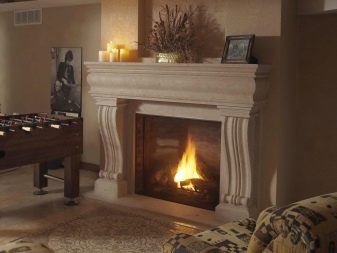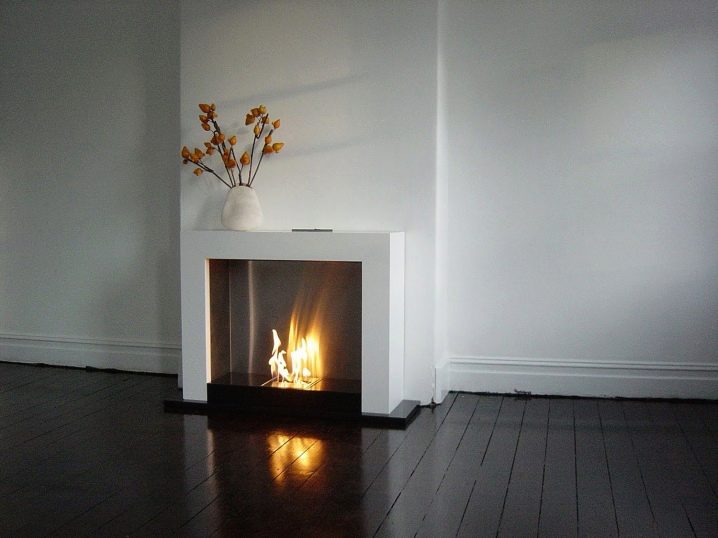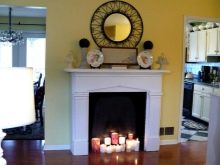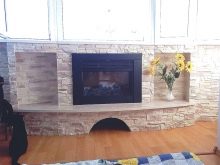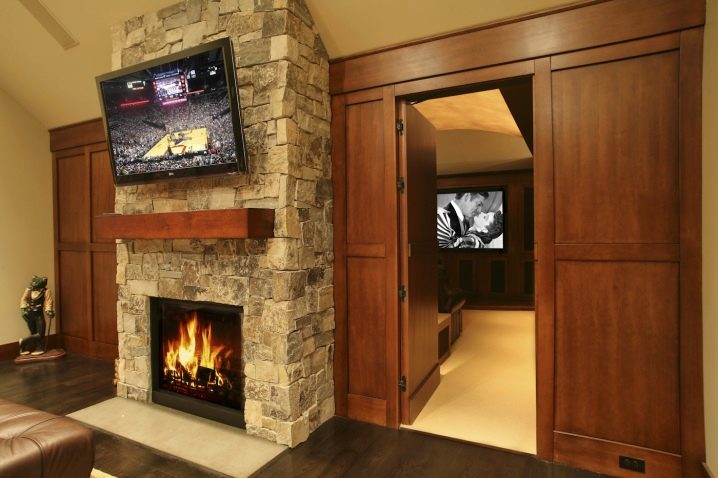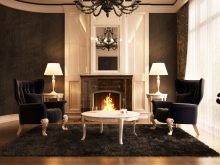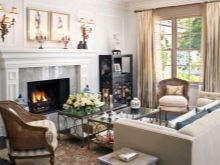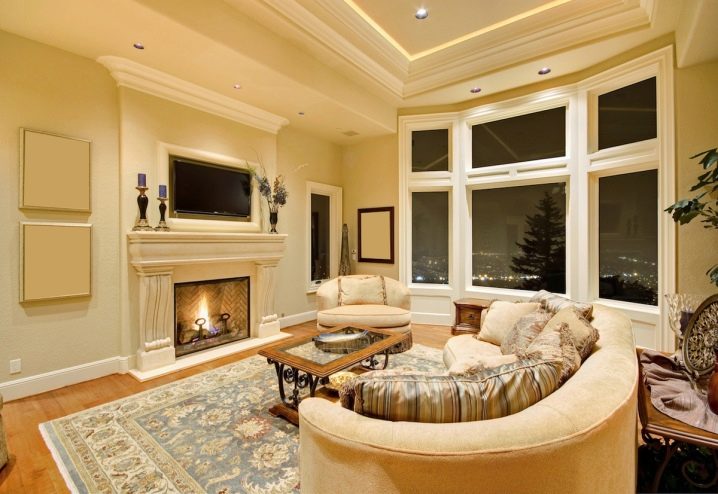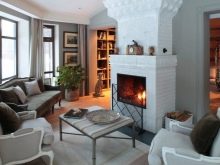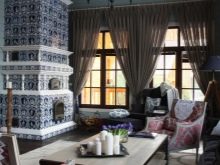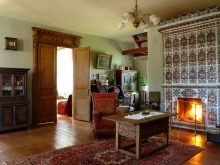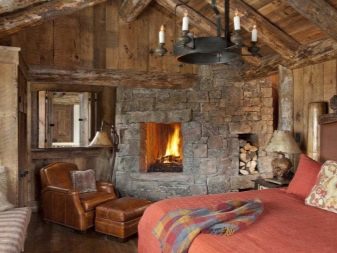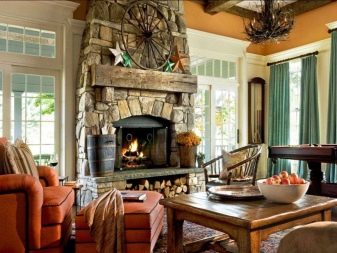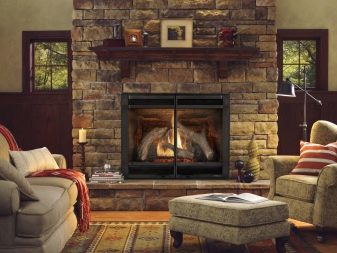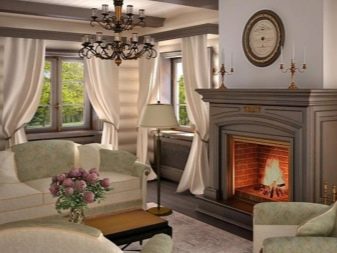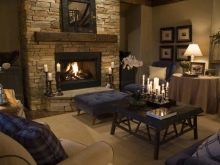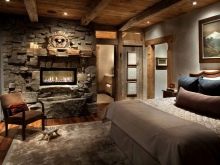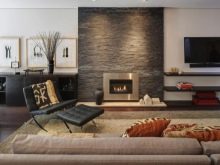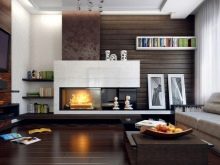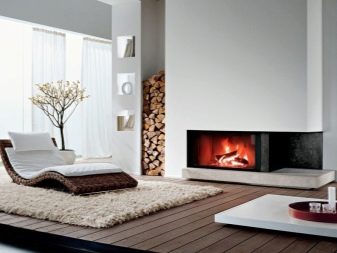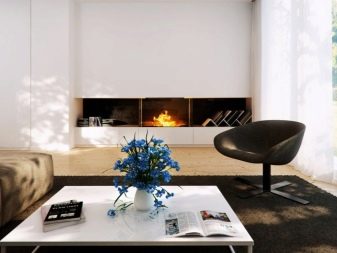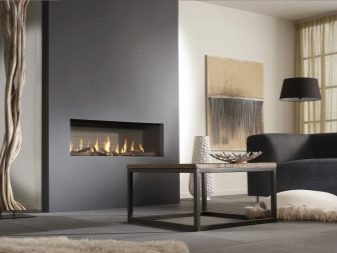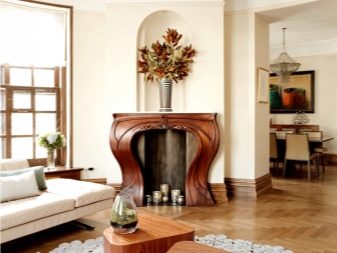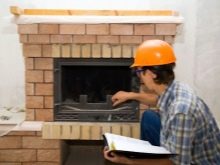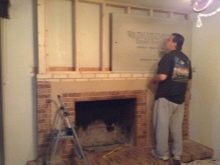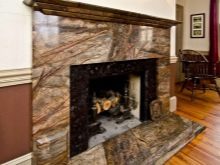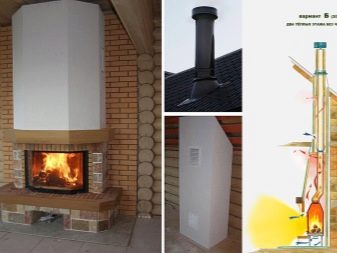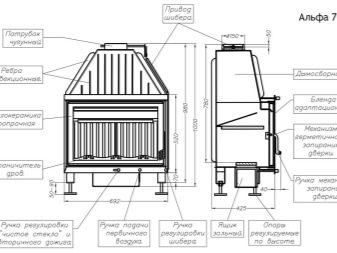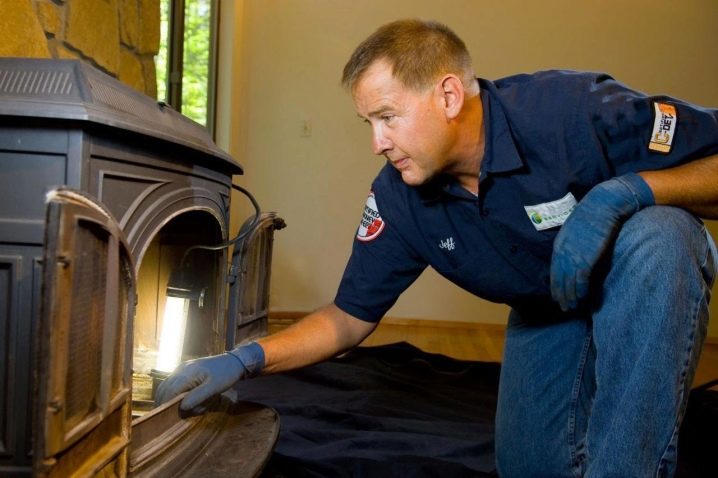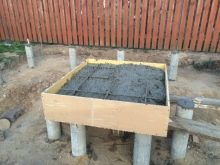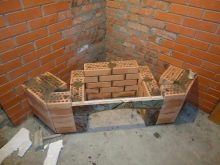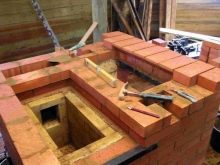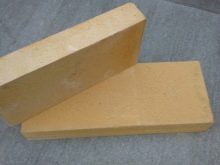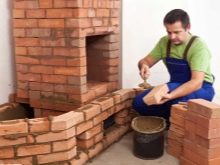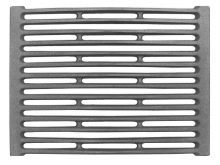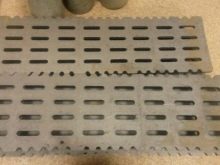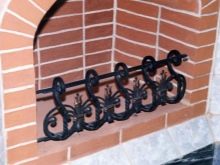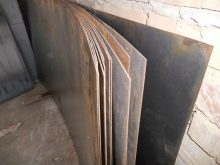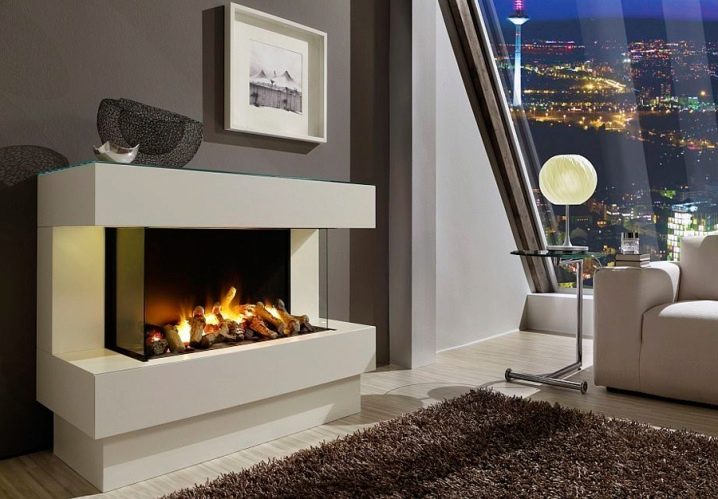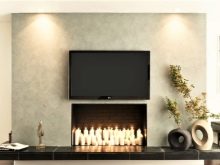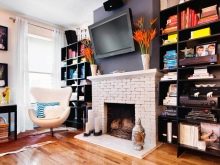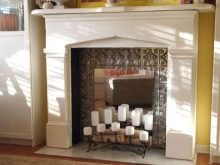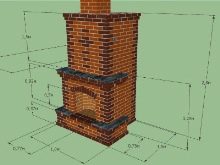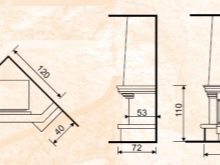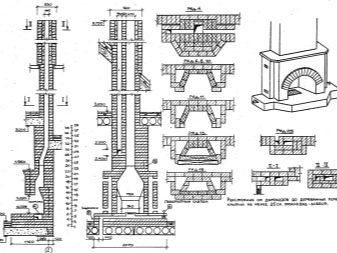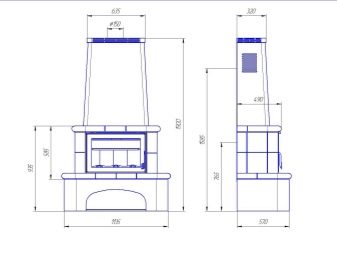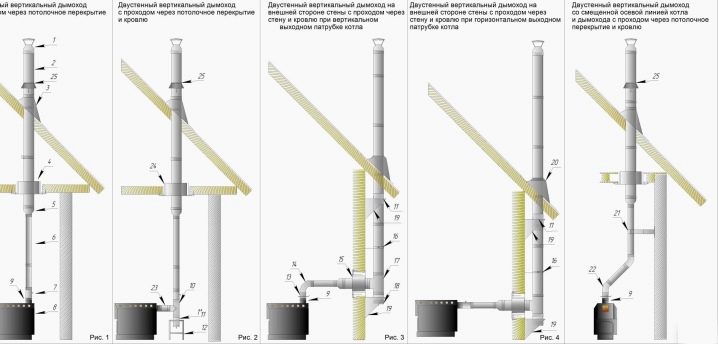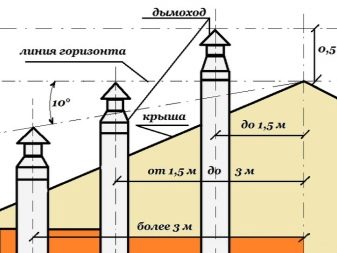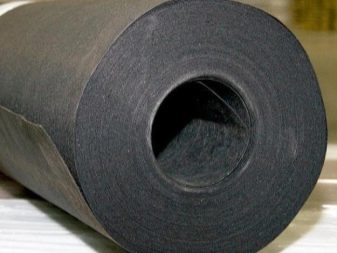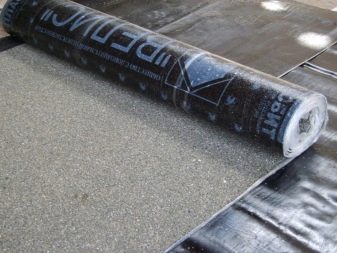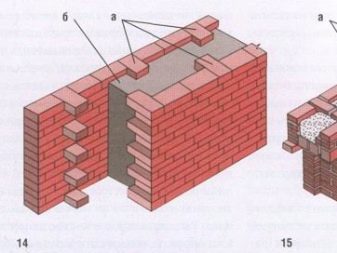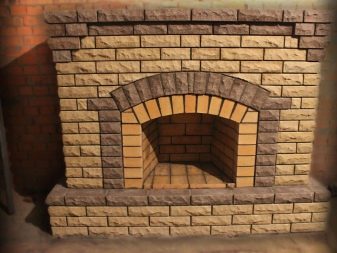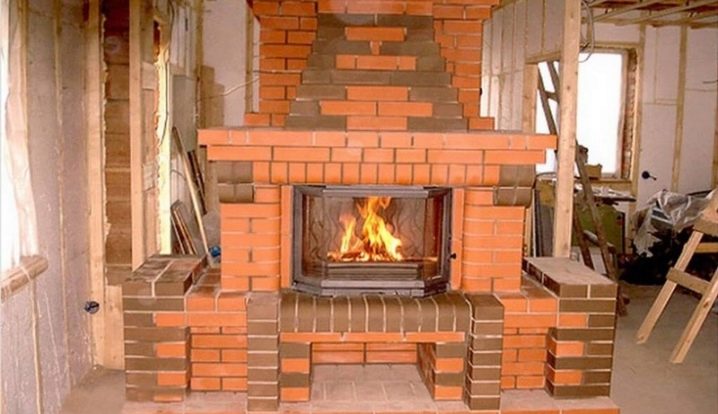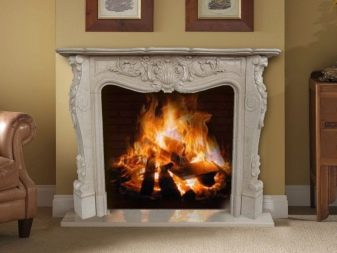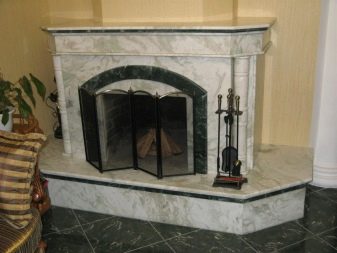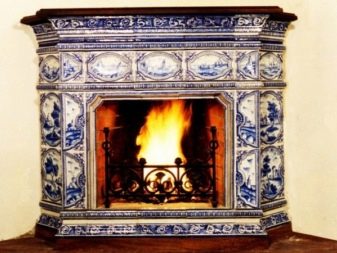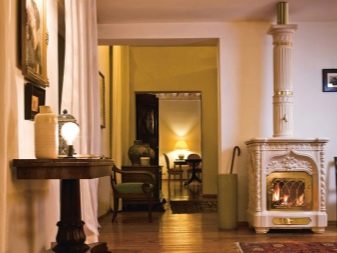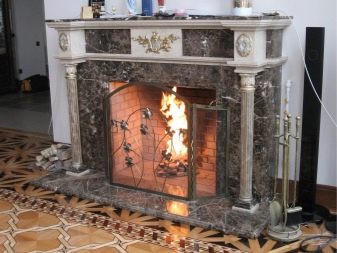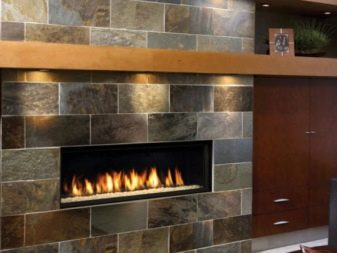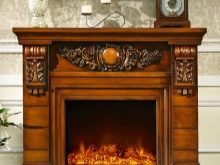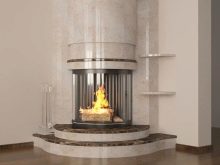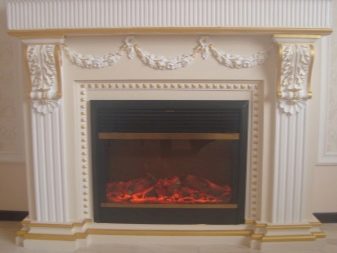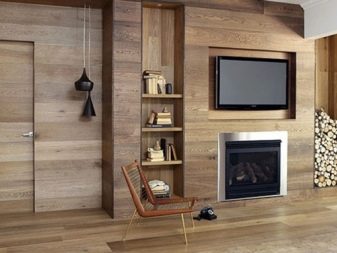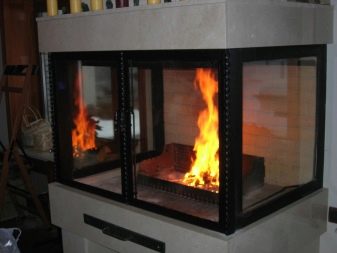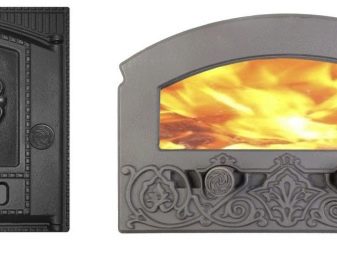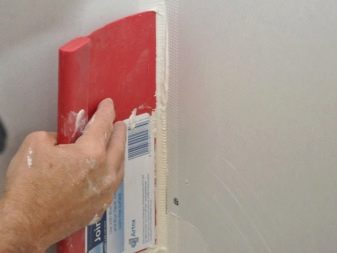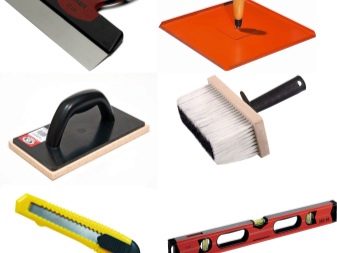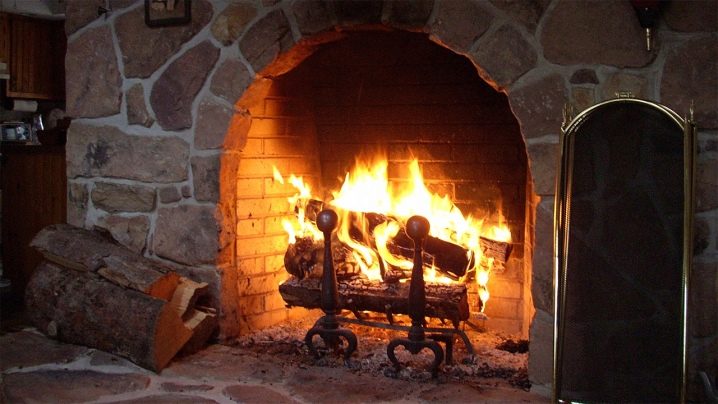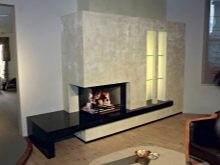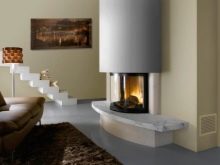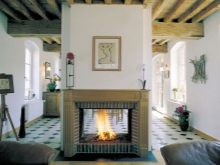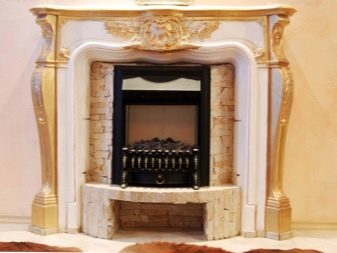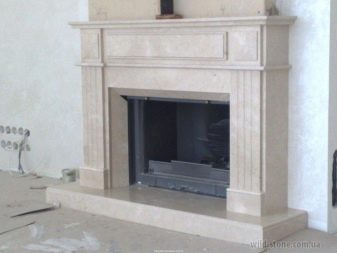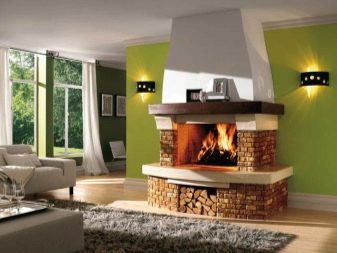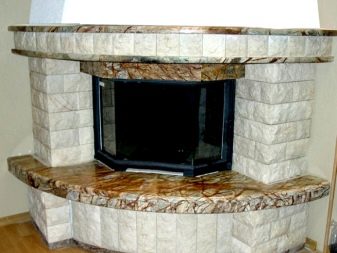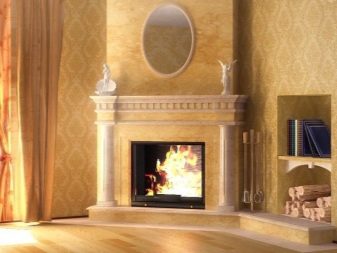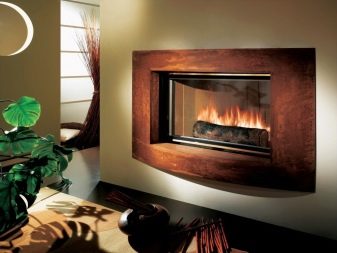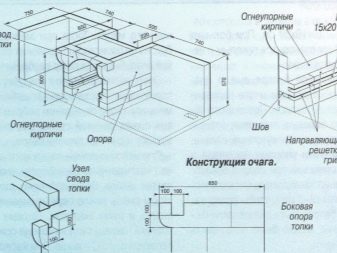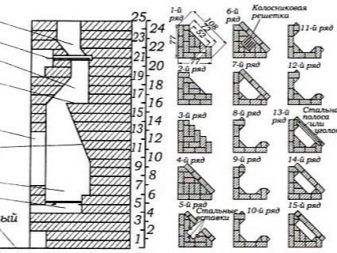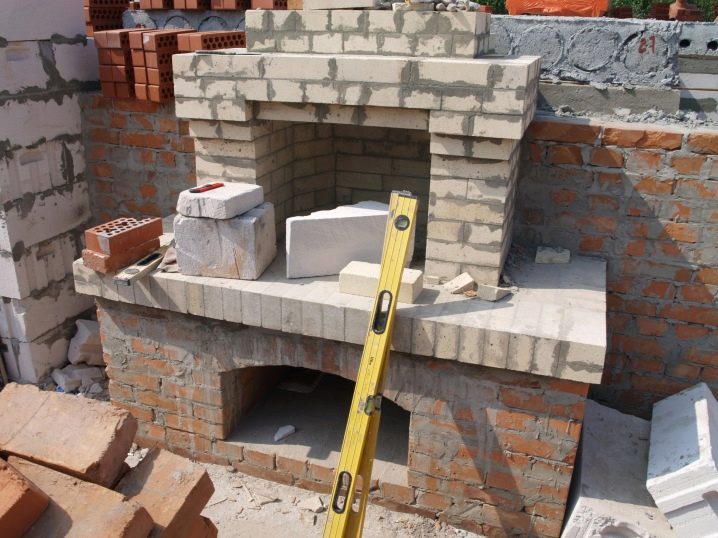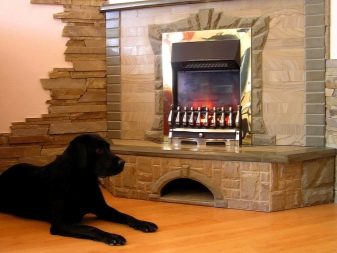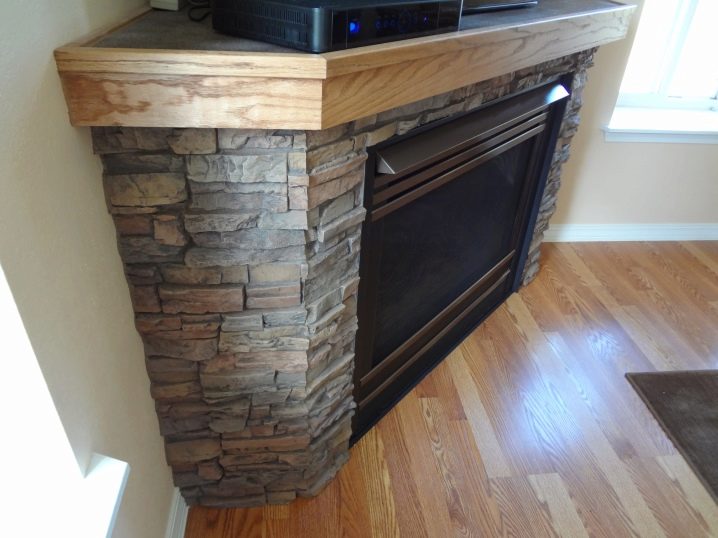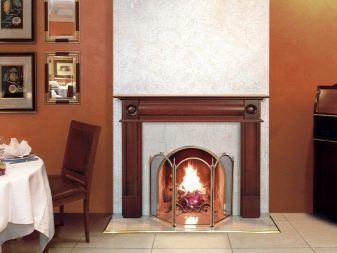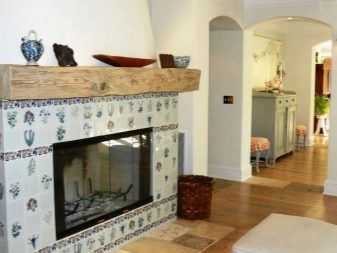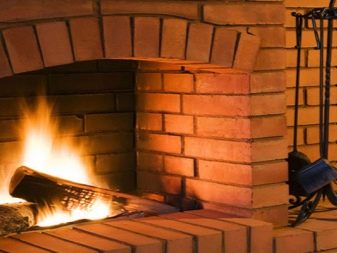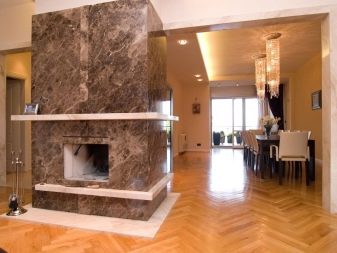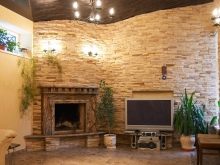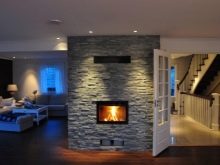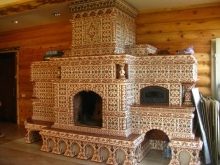We make a fireplace with our own hands
Fireplace - a unique element of the interior. In addition to the practical function, it also carries a decorative. The room with the fireplace takes on a homely and cozy, but at the same time a noble look. It is nice to spend a family evening, a friendly meeting or a romantic date around him. And how well it fits into the Christmas decoration of the house, you should not even say. But in modern buildings fireplace - a rarity.
If it was not laid during the design of the house (and decorative - during the design of the interior design) to fix it is not so difficult - stock up on materials and make a fireplace with your own hands.
What it is?
A classic fireplace with a room heating function is a heating device with an open hearth and a ventilation system for removing smoke from a room. In fact, this is a modification of the first English fireplaces.In Tudor times, they literally looked like a bonfire in the middle of a room. The bonfire was located on a stone fire pit of a small height, and the smoke came out through the thatched roof and empty window openings.
With the development of construction, the fireplace was also changing, but its construction was not very complicated. The “indoor fire” was transferred from the center of the room to the wall, equipped with an open firebox, a smoke box and a chimney. A little later, the rear wall became inclined, and the side walls began to be made of reflective materials.
This increased the efficiency of space heating at times.
In this form, it functioned for many years, until the craving for aesthetics turned a simple stone firebox into pompous decorations made of brick, ceramics and metal.
Together with the external changes diversified and design.
A fireplace with live fire consists of the following elements:
- Foundation. It is laid below the floor.
- Tantas. This is a podium or stand for the firebox. In it are established blowers for an oxygen supply. And oxygen, as is known, is necessary for the combustion reaction. Also trenches perform a protective function. They are carried forward for the perimeter of the firebox and prevent the floor from igniting sparks or embers.
- Ashpit. Designed for ash and ash.
- Under. Above the hearth is placed the furnace and fuel combustion occurs. It must be refractory.
- Firebox or firebox. Actually, the space in which the fuel burns. It can be equipped with a grate - a grate on which to put firewood. Such a device allows oxygen to flow from below and improve combustion.
- Cast iron door. Present in the construction of closed fireboxes. Rarely used in modern interiors, but has its advantages.
- Smoke system. It rises heat and communicates with the room through the walls of the masonry.
- Chimneys. Pipe system that removes gaseous substances, soot, odor and smoke. They include various elements for capturing sparks and imparting proper direction to heat flows.
- Portal or estuary. This structural element closes the outer part of the firebox, carries an aesthetic function. May have a visor and a shelf on top. Should not exceed 3% of the room area.
- Decorative items.
- Fittings: doors, barbecue grills, grate, blew, sometimes oven.
Special features
After constructive and external changes, the fireplace has not lost its functions.It is still used for space heating, but as a source of heat from centralized heating and heaters, it has several features.
First of all, the decorative function of the fireplace is inseparable from its practical application. In the modern interior is no longer the most primitive design of the furnace. It should contain a highlight, something that will contribute to its integration into the design of the room and attract the eye to it.
The second distinctive feature is the distribution area of fireplaces. These are regions with a humid climate, where severe frosts do not rage. The fire chamber of the chimney furnace is large, it absorbs significant amounts of air during the combustion of fuel. It promotes effective air exchange. Cold and moist air warms up quickly, the room is dried.
In regions with severe frosts, but dry air, the room with the fireplace will be cool and with a too dry microclimate.
It is better to limit yourself to an electric variant, a fireplace or a fireplace with a closed firebox. Opening and closing the door, you can adjust the microclimate in the room.
In third place - the efficiency of the heating system.It depends on the fuel used. The source of heating in the fireplace stove is radiant heat. At the same time, firewood gives 25-30% of heat, various types of coal and peat - from 50 to 60%.
Advantages and disadvantages
The positive moments are weighty enough to make an effort and start making the fireplace yourself.
Advantages of traditional fireplaces with open and closed firebox:
- The system quickly warms the air. Open fire gives off heat directly to the room, this is an indisputable plus for country houses of irregular living and cottages with a cold lower floor. Actually use in the country.
- Fireplace is indispensable in rooms with high humidity. This may be the first floors of country brick houses, cottages in regions with constant precipitation and nebula. Due to the rapid air circulation, the unnecessary moisture evaporates, the room becomes not only warm but also dry.
- Can perform a culinary function.. Fireplaces are often equipped with barbecue holders or skewers, grills, and sometimes ovens.
- Tells the room a special atmosphere of comfort, symbolizes the home.
- Is playing the role of an unusual element design.
- Decorative fireplace easy to fold yourself.
- Does not depend on electricity. Interruptions in electricity have no effect on it, in contrast to dependent heating systems.
- Can be used at any time of the year.. For example, in cool summer or early autumn, when another type of heating is still early to use.
- With the firebox closed it is possible to regulate the rate of burning. Its efficiency is higher than that of the open.
- Fireplace with a closed hearth, gas and water circuit can heat from 1 room to the whole floor. For two rooms can work corner fireplace. But their device requires the participation of professionals and will cost a significant amount. Such systems should be laid immediately in the process of building a house. For apartments they are not available.
Not to mention the significant drawbacks:
- Projects of modern and standard houses do not imply the presence of a fireplace. To install it, you will need a house diagram, a detailed drawing, and professional participation. Permission to build an open or closed fireplace on solid fuels is a separate and complex topic.
- Laying a working fireplace - troublesome, dusty and long process. Ideally, it requires skilled help stove.
- The fireplace can not be the main source of heat in the house, because the design does not have the ability to accumulate this heat. The fireplace heats while it works. As soon as the fuel burns through, it begins to cool. If we are not talking about a cottage or a cottage, but about an apartment in an apartment building, a traditional fireplace with a living fire cannot be organized at all. Here its function is purely aesthetic.
- Low efficiency with high fuel consumption. This increases the financial cost of maintaining the fireplace.
- The limited range of the traditional fireplace with an open hearth. A fireplace in the center of the room and near the wall heats only one room. Heat is unevenly distributed.
- Requires maintenance (chimney cleaning).
- The high cost of bookmarks and arrangement.
Far from all the premises it turns out to equip a traditional solid-fuel fireplace stove, so alternative options have emerged. These are gas and electric fireplaces. They also have their pros and cons.
Gas fireplace on the principle of operation and appearance closer to the traditional.
Among its advantages are features such as high efficiency and speed of work, the ability to regulate the speed and intensity of combustion, safety, quiet operation and high speed of heating the room.In addition, there is no need to stockpile and store fuel, and gas at a cost price is cheaper than firewood. They can heat the whole floor.
The disadvantages of such a fireplace are obvious: the complex installation of the gas system, the lack of charm and aesthetics of real fire, large dimensions and weight.
Fireplaces of new generation are powered by electricity.
They have all the advantages of modern technology:
- installation does not require the involvement of specialists, is done by hand;
- simple and clear mechanical and remote control;
- adjustable level of heat intensity;
- can be suspended, angular, non-trivial shape and configuration;
- there is no need to lay a chimney, make a foundation and think about fire safety;
- works silently, without smoke and soot;
- has a small weight;
- realistic flame looks.
There are relatively few minuses: the lack of coziness and crackling of firewood typical for a traditional fireplace, high energy costs, the ability to heat only one room, and dependence on electricity.
Kinds
All modern fireplaces are divided into several types according to four criteria.Conditional criteria: type of fuel, type of construction, type of installation, purpose.
There is another classification - by place of origin. It is customary to single out English, French, Estonian, Finnish, German, Russian fireplaces.. Their internal structure has small differences, so this classification is important only for the appearance of the fireplace. Remarkably, the Russian fireplace has a relatively small size and is called the small chamber.
The type of fuel fireplaces are:
- Solid fuel (heat is obtained in the process of burning wood, peat or coal). These include traditional open fireplaces, stoves, and devices with a closed firebox. The first version has the lowest efficiency - up to 25%, the rest - up to 80%.
- Fireplace with air heating. This is a kind of solid fuel devices, working on a closed firebox. Its design provides a convection system for air flow to increase efficiency and efficiency.
- Fuel oil. Such types are called ecofirestone or biofireplace. Sometimes there is the name "alcohol". This is due to the fact that they use liquid combustible materials of natural origin, for example, bioethanol or ethyl alcohol. In the process of combustion in the air does not emit smoke and soot.They can be used both in the house and in the apartment. According to the method of the device they are the most simple. No dirt, dust, smoke, smell, just pure heat. Bioethanol has the highest efficiency - from 80%. The flame is maintained due to the reaction with oxygen, there is no need to bring it in addition and install ventilation.
- Gas (according to the principle of operation they resemble gas stoves). They are the most economical to maintain.
- With water circuit (similar to centralized heating). They are very complex in arrangement, but they cover a maximum of the area for heating.
- Electric (similar to heaters). Unlike heaters, they are not mobile, but aesthetically appealing. The radius of heating is small, the energy costs are large.
The classification according to the installation method depends on the location of the heating device indoors. There are few options: island (in the center of the room), built-in (recessed inside the wall), wall, corner.
The island fireplace, as a rule, becomes the central element of a design composition. The whole interior is built around it. The element is certainly beautiful, but ineffective.Insular are more often electric and ekokaminy.
Constructively, this is just a heat-resistant base on which a fire is made.
The perimeter of the base may be enclosed with glass or grating. The second option requires special safety measures. Above the base is a smoke box and chimney.
The base with a protective fence is one-sided (when the fire is visible only on one side, the other walls are “deaf”), two-sided (viewed from several sides, often opposite), three-sided, viewed from any point.
The built-in fireplaces are either “embedded” in a thick wall or embedded in a column.. The entire structural part is completely hidden.. This saves space and gives the fireplace an aesthetic look. A common type of built-in fireplace - cassette with a closed firebox. The firebox closes with a glass door so that the device does not lose its aesthetic function.
Built-in fireplace is good when laid at home when planning. Otherwise, he risks becoming the most time-consuming to manufacture, since the necessary niche in the wall will have to be cut through.
Wall fires completely protrude into the room.. This limits their use to medium and large rooms. Compared to others, this type also has its advantages. This is an opportunity to install it at any time, even after the completion of the house, and the variability of the design. Ways of finishing and decorating are not limited.
Corner fireplaces are not widespread. in a modern interior. Now they can be found only in the houses of the old stock and apartment-type museums. Meanwhile, this is one of the most practical types, since its location allows you to warm up two adjacent rooms at once. And the placement method saves usable space in the room. Design thought is also not limited to location.
Suspended view limits the choice of fireplace type of fuel.
Due to the large size and weight of solid fuel and gas structures, they cannot be used in a position cut off from the foundation. The water circuit is also not suitable. There are only two varieties - alcohol and electric.
They are lightweight, and the absence of a chimney makes it possible to place them absolutely anywhere. Often he takes a central or stance position.because its compactness and design features to this have. The shape of this fireplace can be rectangular, and oval, and round, and square, and any design ideas you want.
By appointment, there are two types of devices: functional and decorative.
Both functions may be present simultaneously.
The functional are fireplaces for additional heating of the room, a device with a culinary function. They are relevant for a country house, a country cottage, attic floors of an apartment building. Electric and alcohol - for apartments with a cold ground floor.
It is customary to rank as decorative:
- Lzhekaminwhich has only a mouth with a non-working firebox. He sets up exclusively to maintain the design in a certain style. Often it is a wall or corner design with the most realistic device. It is not mobile, it is used in apartments and warm cottages, but not in a cold cottage.
- Raised fireplace. It differs from a false fireplace in that the construction is temporary. It is mobile and made on occasion. For example, to decorate the living room for the New Year, for a thematic family photo shoot.In fact, these are simple decorations made of wood, chipboard, plywood, plastic and other improvised materials. They can even include materials of an ornamental nature for children's dolls or puppet shows at home or in the theater.
Classification of fireplaces by design is the most diverse and requires detailed consideration.
Style and design
The architectural and artistic value of the fireplace in the interior is often more important than its functionality. Such an element of the decor can turn the interior style unrecognizable or unrecognizable at first glance into an exact match of the concept, and add a zest to it. At the same time, the variety of styles is great - from constant classics to techno.
Classic
Classicism - a synonym for specularity, clear proportions and lines. He refers to the first options of fireplaces, by the time when they have firmly settled in the homes of different segments of the population and are widespread. The materials of the internal arrangement should be chosen on the basis of the functioning of the fireplace, but for the external decoration of the portal, good and natural products are shown. The more expensive and more qualitative they look, the better they fit into the classical framework..
This classic is not created from fake and cheap materials. At least outwardly, they should look expensive. It is important to make a mouth of solid wood, marble, stone. It is characterized by massiveness. The upper part of the portal is so wide that it serves as a finished shelf. Lamps, clocks, figurines, decorations are placed on it.
Marble and wood portals can have a geometric shape, and can be decorated with carvings.
It is important not to overdo it. The abundance of decorative elements on the mouth of the fireplace is no longer included in the concept of the classical direction. It is the prerogative of pompous styles in the spirit of Baroque, Rococo and Romanticism. They are often referred to the group of classical styles, but it would be more correct to single them out into a group of historical trends. The classic in this case acts as an independent branch.
Its typical representatives are English and Victorian styles. "The highest point" of the development of the classics - Empire.
Baroque and rococo have a place in some modern interiors, but they have already lost their former solemnity and pomp. Palace interiors are too difficult to transfer to the conditions of standard apartments and small cottages. White and gold gamma and complex decorative elements look too pretentious and inappropriate in everyday life. Their relevance is maintained only for rooms with a large area.
In urban living conditions, the fireplace is rarely used for heating.
Its arrangement - decoration, snag to achieve the right atmosphere in the setting.
Russian
It can be safely called a separate art form. Fireplaces in the Russian style try to look like tiled stoves, and a tiled stove is the main decoration in the house. This is an abundance of embossed patterns and colorful drawings. The motifs for the plots are nature, flowers and fruits, myths and legends, fairy tales, needlework (lace, painting on wood).
The tiles themselves are small in size tiles, the predecessors of tiles. They are made of porcelain, earthenware and clay. The tiles are repeatedly burned and covered with transparent enamel, gold-containing paints.
Each fireplace in the Russian style is created only in one copy and is a symbol of identity.
It becomes the central element in the interior, everything else is adjusted to it. The arrangement at the same time is widespread angular and near-wall. To preserve the feeling of authenticity, the fireplace in the Russian style is better to choose solid fuel or gas with a closed firebox.. An electric screen will do. with high-quality imitation of burning firewood.
This style has three dominant directions: “a la ryus” style (common in Europe, depicts foreigners ’vision of Russian interiors in wealthy houses),“ antique ”(interpretation of old-fashioned interiors using modern materials), Russian terem (variations on urban Russian style).
Rustik
This trend is identified with simple, sturdy, but primitive village interiors. He is characterized by the use of natural stone rough processing, the absence of a refined decoration of the portal. A characteristic feature is an open firebox. Such a fireplace should be wood-burning, with live fire, crackling wood and the smell of wood.
For interiors that are alien to the emphasized naturalistic rustic, there are his branches. They are more accurate and allow decorative elements made of metal, wood, closed firebox, electric screens. These include country, Scandinavian style, Provence, chalet.All areas that support the use of natural materials in the decoration.
Modern
This name brings together many areas that have one characteristic feature - the renewal of art. Heavy beauty and pretentiousness fade into the background.
A modern style fireplace (or Art Nouveau, Jugend, Liberty) can retain eclectic features and décor, but its amount is minimized. The combination of different materials begins to be practiced. At the turn of the XIX-XX centuries, Art Nouveau became a prerequisite for all modern styles.
Modern directions
Collective name for different directions. There is a rough industrial loft, and a kind of contemporary decor, and strict constructivism, and metallized hi-tech with its closest relative - techno. Distinctive features of modern fireplaces: an abundance of glass, iron, chrome and mirror surfaces, concise forms, small size. Geometric shapes prevail.
Modern style fireplaces are often built in to save space.
There is no decorative frame in the form of a figure portal, it merges with the wall. Relevant biofireplaces that do not require the organization of the chimney.
Fireplace decorations - this is a common phenomenon. Such fireplaces are made of light in the processing of materials according to the type of polyurethane foam and fiberboard. For the 3-D effect, materials with a large sheet thickness are used. They serve as a New Year's decoration in the living room, bedroom, photo studio. On an ongoing basis, such a fireplace is difficult to make high-quality. It looks fake and too cheap.
Necessary tools and accessories
A set of tools, materials and components to create a fireplace varies depending on its type. The process of making this fireplace with a working firebox is the most time consuming and complex. The easiest way to make a false fireplace as a decoration.
For the manufacture of a working fireplace on solid fuel, gas or water circuit, the list of necessities does not begin with the choice of materials, but with the more important and complex thing - paper design. Theoretically, the fireplace refers to fire elements, especially with an open hearth. therefore before sitting in a chair and listening to the cozy crackling of firewood in the fireplace, you will have to spend from 3 months to six months on upholstering the thresholds of various instances and obtaining permission.
This process is problematic because, at the legislative level, the construction of fireplaces is allowed in limited types of housing.
These are pre-revolutionary buildings, in which there is a separate channel from the ventilation for smoke extraction. Also in a private house you can get a building permit, subject to safety regulations. At the same time in the documents in no case You can not specify a fireplace with an open firebox as such. Building codes prohibited. But to issue it as a transfer of the heating system is quite realistic. Without specification, it will be considered a stove with a closed firebox, and its construction is not yet prohibited.
The order of registration begins with the development of the project, and it is carried out by an instance that has a license for such activities. The next step is to assess the operational status of the home. The main thing in it is the serviceability of the chimney and its revision no more than six months from the creation of the project.
After evaluation with the project you need to visit the offices of the Ministry of Emergency Situations that have a license. This institution must deliver a visa on the project. If not, the project is sent for revision as long asuntil it meets all fire safety requirements.
In addition to the MOE, you must obtain permission from the fire service. After that, you can start work. Upon completion, they will be accepted by a special commission, and the changes made will be fixed on the house plan.
Directly for the construction will need:
- Solution for filling of the base and fittings. With a large weight of the whole structure, the foundation must be reinforced with a steel grid so as not to crack.
- Two iron sheets 15mm thick. One is laid directly on the foundation, the second - on top of waterproofing with removal of 100-150 cm.
- Two sheets of ruberoid. They perform the function of insulation between galvanized steel sheets.
- Brick. Regardless of the front of the fireplace, its hearth is laid out of red ceramic bricks. They can also finish the chimney along the internal contour. Particular attention is required to pay "tricks" - bricks, fitted to a non-standard shape and size. The material should be free of cracks, defects, burned dark areas. It is sufficiently resistant to fire and will last for many years.
- Fireclay plates. They laid out under the furnace.The material is refractory and designed specifically for stoves and fireplaces.
- Clay-sand mixture for masonry. It is allowed to use only clean construction clay and alluvial river sand. The proportions of the components of the mixture - 3 parts of sand to 1 part of clay. Cement and alabaster solutions are not suitable. Masonry will not hold. Together with the tank for the solution you need to purchase a construction mixer, mortar spade, trowel and rule.
- Also need: smooth flat boards for formwork, asbestos cord, grinder for fitting bricks in size, drawing and measuring tools, plumb and level, trowel, construction stapler, shovels, hammer with iron nozzle and rubber (for leveling masonry).
- Additional elements: grate, ventilation pipes and grates, ash pan in ashpit, protective screen against sparks and embers, poker and decorative elements. In simple design, this is a fireplace portal or mouth.
Electrical points are installed in a simplified scheme. Since they do not require a chimney and are no more dangerous than a conventional heater, no permission will be required.Bypassing the paperwork, you can immediately proceed to the arrangement of the fireplace.
By itself, an electric fireplace is quite light and does not heat up to high temperatures.
To install it, you will need a frame made from a metal profile, sheets for plating, finishing materials for joints, material for decorative finishing and the accompanying trifles in the form of self-tapping screws and fasteners for connecting the frame to the wall. You will also need cutting tools, a drill or a screwdriver, and measuring and drawing accessories.
For false fireplaces, drawing materials, cutting tools are needed to cut out parts, fasteners in the form of screws or liquid nails, paints, stabilizing elements (so that the structure does not collapse), and decor.
How to do it yourself?
Manufacturing technology of the fireplace depends on its type. Dummy fireplaces are easy to manufacture. The hardest thing to build a real, working fireplace with an open firebox. We do not consider gas heating and water circuit options at all, since their arrangement requires the intervention of specialists.. Even the instructional video in this is not an assistant.Incorrectly connected gas equipment or a boiler can cause serious damage to the house and even become a threat to the life and health of its inhabitants.
Before the start of installation, it is important to carry out several preparatory procedures. Typically, this paper design, the calculation of the size of the fireplace, the choice of materials from which will be made of the "body" of the fireplace and its mouth, the choice of the form of the portal, the color of the exterior and decorative design.
Dimensions
Calculating the size of the furnace is the most important design stage. It is carried out relative to the dimensions of the heated room. It is conditionally possible to divide all fireplaces into mini, medium and large. Mini fireplaces are designed for rooms of 10-12 square meters. A small fireplace will have a firebox 400-420 mm wide, 420 mm high, 300-320 mm deep. These are the dimensions characteristic of a small stove. The shape of the firebox is narrow and elongated or square.
Another kind of small fireplaces designed for rooms with an area of 13.5-15 square meters. m. The width of the furnace - 450-500 mm, height 450-490 mm, depth - 320.
The height of the smoke box for small fireplaces - 570-600 mm.
The average room size of 18-25 squares requires fireplaces with a portal size of 600-700 mm. The recommended height is 560-630, the depth is 320-350. The optimal height of the smoke box is 630-660 mm.The shape of the firebox at such a fireplace is square or rectangular, with a longer side horizontally.
For very spacious rooms of 30-40 squares in size, a fireplace is needed with the parameters W × H × G equal to 800–900 mm x 700–770 x 400–420 mm. Smoke box at a height of not less than 700-800 mm.
The vertical rear wall should not be less than 360 mm for all types of fireplaces. The minimum cross section of the chimney is 140 mm.
More accurate calculations are made by the formula. So, to determine the size of the furnace, you need to divide the total area of the room by 50. At the same time depth in relation to height is 2: 3. Too deep firebox reduces the already not very effective heat transfer during combustion of fuel. All the heat will go along with the smoke to the street. A small firebox, on the contrary, will cause some of the smoke and soot to settle in the room.
It is important to calculate the size of the chimney. Its width must be at least one tenth of the width of the firebox. For a round pipe, these are the diameter indicators.
Materials
The firebox and chimney are almost always made from the same material - red ceramic brick. Brick is hollow and solid. For the fireplace is more suitable solid.It withstands high temperatures, does not crack, has no pores. For the foundation you need a concrete or cement mixture. Concrete is cheaper, cement is more practical. If cement, then 300 marks.
Before setting up the hearth, galvanized metal sheets and a layer of waterproofing and heat insulation are laid. The base of the furnace can be further protected from cracking with the help of fireclay plates. Also suitable refractory refractory bricks.
Heat-insulating material is a rolled cardboard impregnated from resin and sand sprinkled.
For example, roofing. In order for it to perform its function, it is necessary to lay it on the mastic. For fireplace requires bitumen or tar mastic. Inside the chimney itself, metal pipes are used.
Brickwork should be a monolithic, solid and smooth construction. For the "clutch" bricks used solutions of minerals, water and aggregate. Natural minerals are different types of clay, lime, cement and gypsum. The optimum is considered clay base. The role of the aggregate is played by high-quality fine sand.In conditions of constant exposure to high temperatures, mountain sand has recommended itself better.
More variable finishing portal. At the mouth there is no heat load, there is no direct exposure to fire, so the choice of materials is quite wide.
The main criterion here is no longer resistance to fire, but susceptibility to processing and compliance with the design idea.
For the manufacture of the portal are used:
- Marble. Marble portal looks expensive, elegant, but not too elaborate. It is appropriate in classic interiors in combination with other elements of the Lux segment. Marble fireplace next to simple wallpaper or cheap floor trim will look out of place.
- Granite. An impressive, massive granite portal will fit well into the classics, gothic and Scandinavian interiors. As products made of marble, it requires an appropriate environment, but is more suitable for premises in dark colors.
- Tiles. The most complex and expensive, but at the same time the most spectacular decor. With its help, Russian-style fireplaces are embodied, as well as ethno-fireplaces. Earthenware or ceramic tiles can be ordered in finished form and according to an individual pattern.Tiled mosaic will consist of a limited number of parts-modules. You can not damage them, you can not buy spare ones in the hardware store as a cracked tile. For finishing you will need special tools and binders. It is better to entrust such a responsible event to professionals.
- Ceramics. Having experience with finishing materials, it is possible to adapt ordinary ceramic tiles as tile modules. The event is difficult, but the result is worth it.
- A natural stone. Stone decoration - the prerogative of such styles as rustic, country, chalet. This is an alternative to red brick, which fits perfectly into the atmosphere of a country house.
- Fake diamond. Performs functions similar to its natural brother in design, but costs less.
- Facing brick. This material for the exterior of the portal, which has a different color, texture and texture. The range is large, down to the bricks with pearlescent.
- Wood. The wooden portal is laconic and dignified. Mostly used dark wood valuable species. Wood is appropriate in many interiors, from classics to Provence.
- Galvanized profile. Rough metal finish is typical of Scandinavian-style rooms. She also has industrial features that is why she will organically fit into a loft-living room or studio. Beautiful forging, voluminous metal parts and gratings are integral elements of the Victorian fireplace design.
- Gypsum. The mouth of the plaster is used in the case when the fireplace portal should look like a quality stucco. This stucco will cost quite expensive, but the gypsum analogue is available even with a small budget. The decor can be either a classic style or more complex, for example, in the Baroque style.
- Floorboard. It is used for finishing small fireplaces. The wide and high portal, which has a shelf on top, is already difficult to trim with narrow lamellas.
- Natural wood derivatives. You can make a beautiful carved portal with your own hands and from budget materials. All types of plywood, a chipboard without the laminating covering, DVP, OSB and MDF belong to them. All these materials belong to the sheet, have a sufficiently large width and length to make a portal from a single piece, are easy to process.
When the firebox is closed, cast iron doors or fireproof glass are usually used.
The portal for electric fireplace is made in the form of a frame from a metal profile and corners. Sheathed frame drywall sheets. Screws are used as fasteners.
As for the false-fireplaces, their portals are made from different materials in accordance with the idea. Bulk portals look more spectacular from thick, “bloated” materialseg foam or polyurethane. A hard mouth can be constructed from the same wood derivatives as for a working fireplace, as well as from timber and planks. Sheet gypsum board and handy materials are actively used. Excellent service can do the old furniture.
To seal the seams useful putty, liquid nails, painting tools.
For decoration - brushes, paints, self-adhesive film, finishing primer. The remaining items are optional. The mouth of the fireplace can be silver, gold or mother-of-pearl, have volumetric details and depict natural marble.
The form
The location of the fireplace in the room (center, corner or wall) determines the amount of building materials. Its value has a form.Can vary the form of the furnace, and the form of the portal. So, a round fireplace is more difficult to lay out than a square one.
The firebox itself inside is square, rectangular, penal, semicircular and round.
Modern fireplaces also have an oval and triangular shape. The smaller the fireplace, the easier it is to choose the size.. Large fireboxes impose some restrictions. The best option is a rectangle stretched vertically.
The form of the external decoration of the portal is a matter of aesthetic It most often happens in the form of an arch with a shelf on top, a figured edge, and carved decoration. The arch may be rounded or elongated upwards. It is interesting to look arches, outstanding in a semicircle.
Colors
The color palette is determined by the type of finishing materials and is usually limited to natural natural colors.
Gypsum is classically white. It goes well with the golden decor.
Marble can be monophonic (white, black, brown, gray, beige) or in bicolor (a combination of various shades with white, black and gray). It is extremely rare to find a green, pinkish, bluish, colored stone with streaks of the same color. Natural marble is chosen in gray and brown colors, less often - milky.
The facing brick is presented in the market by a various palette, but the limited quantity of colors is used: terracotta, brown, black, white, gray, chocolate, an ivory. It is also presented in the combined versions and with mother-of-pearl coating.
The tree and its derivatives are chosen for painting.
Popular light shades, brushed (aged) dark wood, natural dark wood. Nut shades, tic, wenge are most demanded.
Registration by tiles is not limited in a palette. Such a finish is available riot of bright blue, red, yellow and other colors.
Step-by-step instruction
Stages of manufacturing a fireplace with a working furnace:
- Drawing Design, calculation of the amount of materials.
- Purchase of materials and tools, working uniforms. During the work, you will need a respirator and goggles, since it is dusty and dirty to lay the chimney in the wall (ceiling).
- Preparatory work. At this stage, the excavation is excavated (hollowed out in the old foundation) under the fireplace, and the rubble mixture is poured. A waterproofing material is laid out over the rubble, and the foundation is poured on it. It is reinforced with metal mesh.Drying time of cement mortar - 20-30 days.
- Dilution solution. This is a long procedure, since the clay should soak for 2-3 days. Then sand is poured into the clay solution. On 8 parts of clay 8 parts of sand and 1 part of water. The mixture is thoroughly mixed with a construction mixer until the consistency of sour cream.
- Masonry fireplace. The first two rows are laid out without features, with a gap of 5 millimeters. This is the base of the fireplace. The third row - the bottom of the furnace. It is necessary to lay out fireclay plates placed on the edge. Alternate with other material can not. The grate is also installed here. It is important to note that iron expands more than a brick when heated, so temperature gaps are needed. The fourth row - the beginning of the formation of the combustion chamber.
If there is a leash in the design, it is set in the process of forming the fifth row.
Until the eighth without features, and with it begins the formation of the slope of the rear wall forward. The slope forms a “mirror” to reduce heat loss. Rows 9-15 form an arch, 15-18 - a “chimney tooth”. From 19 to 20 a channel for the removal of flue masses is formed. From 23 the branch expands, contact with the roof is formed (a wall, if the house is above the 1st floor). The chimney is brought out and protected by an “umbrella” from precipitation.
- Install weather vane.
- Fireplace joints cement mortar. After this, the structure should dry out a little.
- Decorative trim. Before it starts, the mortar in the masonry should completely dry.
Making a fireplace with electric heating easier. At the first stage, a frame of the desired shape is assembled from a metal profile, the base of the frame is sheathed with a material resistant to high temperatures. At the second stage, the rest of the structure is covered with plasterboard. In the third, the seams are smoothed with a putty. Fourth - decorative trim. Fifth - mounting the frame to the wall. Sixth - installation of electric fire in an improvised furnace.
Raised fireplace for a New Year's photo shoot and decorations can be made of wooden slats, sheathed fiberboard or plasterboard, plywood from old furniture. It is not attached to the wall so that after the holidays it was easy to remove it without damaging the wall decoration.
Tips and tricks
Tricks to create the perfect fireplace:
- It is worth starting with a sketch. This will give a visual idea of how the fireplace will look in the interior.
- The fireplace is located at a distance from doors, windows and heating appliances.
- Fireplace decoration should be in harmony with the style of the interior or set the tone for it.
- Before starting the construction of a fireplace on solid fuel, it is recommended to protect all surfaces from cement dust as much as possible, and to bring furniture to another room.
- Numbered bricks are laid faster and easier.
- The brick should not be hollow.
- It is not recommended to build a hotbed in the off season and in the cold season.
- Solid fuel fireplace requires maintenance and periodic cleaning of the chimney.
- The best option for the apartment - alcohol fuel.
Beautiful examples and options
The beauty of a homemade fireplace is determined by its location and type of decoration. A win-win is a portal made of concrete or marble. It looks expensive and for a long time preserves the presentable appearance of wood trim.
In a private house, a fireplace decorated with stone in a country-style or rustic style, as well as a semi-antique Russian style and a tiled finish organically blend in. The interior of a modern apartment is appropriate electric or ekokamina non-trivial form with metal and tempered glass.
How to make your own installation of a decorative fireplace, see the following video.
